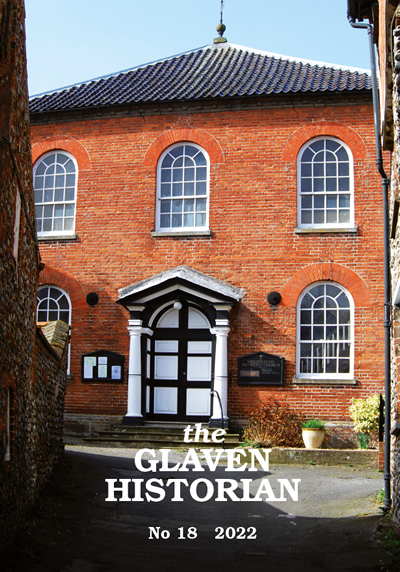This issue is not yet available online. Click here for information on purchasing a copy.

Click here to view Cover pages (they will open in a new tab or browser page).
Contents
A vanishing landscape: archaeological investigations at Blakeney Eye. A review of the final report
John Wright
Synopsis: Sixteen years after the excavations on Blakeney Eye the final report describing the finds and outlining the history of the site has been published. This review aims both to summarize and to comment on the content of the report. Most reviews of non-fiction books are written by people qualified to make a critical appraisal of the conclusions being put forward. The author of this review is not an archaeologist but is familiar with the site long known as the ‘Chapel’ on the Eye and took part in the surveys undertaken there by the Blakeney Area Historical Society before excavations began. The review suggests that some of the conclusions arising from the finds and stratigraphy described in the report are not the only possible ones.
‘Spreading the heavenly contagion’: the coming of the Methodists to the Cley area 1757–1815
Margaret Bird
Synopsis: Methodists arrived as early as 1757 in north Norfolk. These were not the Wesleyans, but their active competitors— the Calvinistic Methodists of Lady Huntingdon’s Connexion. The bitter divide between George Whitefield and John Wesley, the fathers of English Methodism, was played out on the ground across different parts of the country. Additionally, the Nonconformists had to compete with roving Church of England priests. These thrusting young Evangelicals had mostly been trained in Cambridge for their mission to awaken souls where the Established Church was thought to be failing. It proved an exciting time for parishioners, who found themselves courted by waves of itinerant preachers. First we examine how well equipped the parish clergy were to withstand the challenges facing them.
Privateers, the press gang and service in the Sea Fencibles: the pressures on Blakeney and Cley’s seafarers c.1800
Margaret Bird
Synopsis: This is an expanded version of an unscripted talk given to the BAHS at Cley on 30 November 2021.1 It covers aspects of life at sea and in coastal communities which are often neglected by maritime and defence historians in the period of the French wars 1793–1815. Far more merchant ships were lost to enemy privateers than to attack by warships. The depredations caused by privateers in the North Sea are exemplified by the twelve-year career of the small sloop Nelly, a Dundee-built ship which spent her last four years operating from Blakeney Quay. The Royal Navy’s Impress Service, known as the press gang, posed a constant danger to merchant seamen and those in related trades. Lastly, this study highlights the significance of the local ‘Home Guard’, the Sea Fencibles, who served 1798–1810. Their records in the National Archives are a boon for family and local historians.
The disastrous summer storm of 1833
Jonathan Hooton
Synopsis: An account of the great storm of 31 August – 1 September 1833 in which as many as 15 vessels were blown ashore between Stiffkey and Cromer, two of which were complete wrecks, and a further 29 around Wells and King’s Lynn. The images in this article are all photographs of ships wrecked later than 1833, but give an impression of what the wrecks of 1833 would have looked like.
The pier harbour at Blakeney
Jonathan Hooton
Synopsis: This is a note of contemporary newspaper accounts of a proposal to build a Pier Harbour at Blakeney in 1835, which was never carried out. It first appeared in the BAHS Digital Newsletter 7 (November 2021).
The Brereton dynasty: a family of 19th century engineers and the Blakeney connection
John Wright
Synopsis: A note on the distinguished Victorian engineer Richard Pearson Brereton (1818-94), assistant to I. K. Brunel, who was born at the Red House, Blakeney, and about two other members of the Brereton dynasty, also engineers and also from Blakeney: Cuthbert Arthur Brereton (1851-1910) and Robert Maitland Brereton (1834-1911).
Two men united through heroism: Howard Brett, Cley Rocket Company and William Hibbert, HM Coast Guard
Richard Jefferson
Synopsis:
BOOM!
Eric Hotblack
Synopsis: The author describes a piece of sandstone found while field-walking at Field Dalling. This may have been deposited by a drilling rig carrying out a seismic survey in the 1960s searching for oil and natural gas, later found in the North Sea.
